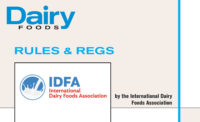In January of 2009, the FDA proposed modernizing the yogurt standard of identity, with the goals of supporting recent technological advances and increasing consistency with international yogurt standards. Interested parties were politely requested to send in any comments to the proposed rule within two months.
Twelve years later, on June 11, 2021, the FDA published a final ruling on the matter in the Federal Register. The International Dairy Foods Association (IDFA) has been an enduring advocate for such an update and commends the FDA for taking this first step for the benefit of consumers, industry, and public health.
Modernized, but not enough
The new FDA ruling modernizes one of many obscure but significant regulations known as standards of identity, which determine the allowed ingredients, composition, and processes that food companies can use for various food products, including yogurt. Under the new rule, the FDA is showing its support for the use of a wider variety of dairy ingredients to make yogurts that are innovative and meet consumer demands for nutritious and tasty products.
The new rule also consolidates three redundant and outdated standards that had been in place since 1981 for “yogurt,” “low-fat yogurt” and “nonfat yogurt,” among other important modifications, yet aims to preserve the basic identity and characteristics of “yogurt” that consumers expect and differentiate it from other dairy products.
Unfortunately, IDFA believes the rule goes does not go far enough in modernizing the standard and in keeping up with current industry practices and consumers’ demands for yogurt products.
Standards of identity have a profound impact on the dairy industry. There are currently 280 federal food standards of identity, most of which were put into place many decades ago.
Some 100 of those rules apply to yogurt, cheese, milk, ice cream, and other dairy products. These regulations have, in many places, lapsed into obsolescence and are in dire need of modernization to account for new technologies, ingredients, and novel processes used in the dairy industry.
IDFA’s efforts in support of modernizing the yogurt standards go back to at least the year 2000. Sadly, this is not the only issue that has languished for years inside the FDA bureaucracy. In 2006, IDFA, along with fellow food industry trade associations, submitted a separate request to FDA to establish a novel “horizontal approach” to the FDA food standard development process that would allow for faster and easier changes to the standards. As with several other proposals resting with the agency for many years, this matter has not yet been resolved.
While any progress is superior to the status quo, the exceptionally long timeline for updating yogurt standards underscores the need for increased urgency and transparency on the part of regulators, as the industry and consumers are changing at a much faster pace than the agency can respond.
The men and women who staff our government regulatory agencies — and the political officials who oversee them — must be more responsive to the pressing needs of industries such as ours that depend on timely guidance and promulgation of regulations to be competitive and responsive to consumer needs.


